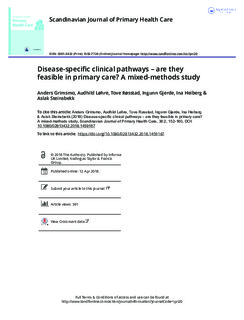| dc.contributor.author | Grimsmo, Anders | |
| dc.contributor.author | Løhre, Audhild | |
| dc.contributor.author | Røsstad, Tove Garåsen | |
| dc.contributor.author | Gjerde, Ingunn | |
| dc.contributor.author | Heiberg, Ina Heidi | |
| dc.contributor.author | Steinsbekk, Aslak | |
| dc.date.accessioned | 2018-08-28T13:26:13Z | |
| dc.date.available | 2018-08-28T13:26:13Z | |
| dc.date.created | 2018-04-16T08:20:26Z | |
| dc.date.issued | 2018 | |
| dc.identifier.citation | Scandinavian Journal of Primary Health Care. 2018, 36 (2), 152-160. | nb_NO |
| dc.identifier.issn | 0281-3432 | |
| dc.identifier.uri | http://hdl.handle.net/11250/2559698 | |
| dc.description.abstract | Objective: To explore the feasibility of disease-specific clinical pathways when used in primary care. Design: A mixed-method sequential exploratory design was used. First, merging and exploring quality interview data across two cases of collaboration between the specialist care and primary care on the introduction of clinical pathways for four selected chronic diseases. Secondly, using quantitative data covering a population of 214,700 to validate and test hypothesis derived from the qualitative findings. Setting: Primary care and specialist care collaborating to manage care coordination. Results: Primary-care representatives expressed that their patients often have complex health and social needs that clinical pathways guidelines seldom consider. The representatives experienced that COPD, heart failure, stroke and hip fracture, frequently seen in hospitals, appear in low numbers in primary care. The quantitative study confirmed the extensive complexity among home healthcare nursing patients and demonstrated that, for each of the four selected diagnoses, a homecare nurse on average is responsible for preparing reception of the patient at home after discharge from hospital, less often than every other year. Conclusions: The feasibility of disease-specific pathways in primary care is limited, both from a clinical and organisational perspective, for patients with complex needs. The low prevalence in primary care of patients with important chronic conditions, needing coordinated care after hospital discharge, constricts transferring tasks from specialist care. Generic clinical pathways are likely to be more feasible and efficient for patients in this setting. Keywords: health service research, care coordination, integrated care, general practice, home health nursing, practice guideline, multimorbidity | nb_NO |
| dc.language.iso | eng | nb_NO |
| dc.publisher | Taylor & Francis | nb_NO |
| dc.relation.uri | https://doi.org/10.1080/02813432.2018.1459167 | |
| dc.rights | Navngivelse-Ikkekommersiell 4.0 Internasjonal | * |
| dc.rights.uri | http://creativecommons.org/licenses/by-nc/4.0/deed.no | * |
| dc.title | Disease-specific clinical pathways - are they feasible in primary care? A mixed-methods study | nb_NO |
| dc.type | Journal article | nb_NO |
| dc.type | Peer reviewed | nb_NO |
| dc.description.version | publishedVersion | nb_NO |
| dc.source.pagenumber | 152-160 | nb_NO |
| dc.source.volume | 36 | nb_NO |
| dc.source.journal | Scandinavian Journal of Primary Health Care | nb_NO |
| dc.source.issue | 2 | nb_NO |
| dc.identifier.doi | 10.1080/02813432.2018.1459167 | |
| dc.identifier.cristin | 1579417 | |
| dc.description.localcode | © 2018 The Author(s). Published by Informa UK Limited, trading as Taylor & Francis Group. This is an Open Access article distributed under the terms of the Creative Commons Attribution-NonCommercial License (http://creativecommons.org/licenses/by-nc/4.0/), which permits unrestricted non-commercial use, distribution, and reproduction in any medium, provided the original work is properly cited. | nb_NO |
| cristin.unitcode | 194,65,20,0 | |
| cristin.unitname | Institutt for samfunnsmedisin og sykepleie | |
| cristin.ispublished | true | |
| cristin.fulltext | original | |
| cristin.qualitycode | 1 | |

